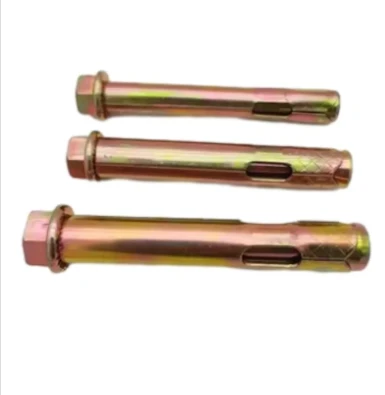Dec . 23, 2024 12:10 Back to list
Understanding Sleeve Wall Anchors and Their Applications in Construction Projects
Understanding Sleeve Wall Anchors A Comprehensive Guide
When it comes to ensuring the safety and stability of structures, choosing the right anchoring solution is crucial. Among various options available, sleeve wall anchors stand out as a reliable choice, specifically designed for use in solid materials such as concrete, brick, and masonry. This article delves into the essential features, benefits, and applications of sleeve wall anchors, shedding light on why they are a favored option in construction and renovation projects.
What is a Sleeve Wall Anchor?
A sleeve wall anchor is a type of mechanical fastener that consists of a threaded bolt, a sleeve, and a nut. The sleeve is typically made of a durable material that can expand when the bolt is tightened, thereby creating a firm grip within the wall material. This expansion mechanism is what makes sleeve wall anchors particularly effective in providing secure, load-bearing support in various applications.
How Sleeve Wall Anchors Work
The installation process of sleeve wall anchors is relatively straightforward. First, a hole is drilled into the wall at the desired location. The diameter and depth of the hole must match the specifications of the sleeve anchor being used. Once the hole is ready, the sleeve anchor is inserted, followed by the insertion of the threaded bolt. As the bolt is tightened, the sleeve expands against the sides of the hole, effectively anchoring the fastener in place. This results in a secure point for attaching fixtures such as shelves, cabinets, or heavy appliances.
Benefits of Sleeve Wall Anchors
1. High Load Capacity One of the primary advantages of sleeve wall anchors is their ability to support significant weight. This load-bearing capability makes them ideal for heavy-duty applications, where other anchors may not suffice.
2. Versatility Sleeve wall anchors can be used in various materials, including concrete, brick, and stone. This versatility allows contractors and DIY enthusiasts alike to use them across multiple projects, whether building or renovating.
sleeve wall anchor

3. Ease of Installation The installation of sleeve wall anchors does not require specialized tools or skills, making them accessible for both professionals and beginners. The straightforward installation process often leads to quicker project completion times.
4. Resistance to Pull-Out Forces Once installed, sleeve wall anchors provide excellent resistance to pull-out forces, which is essential for ensuring the longevity and durability of the structure being supported.
5. Corrosion Resistance Many sleeve wall anchors are manufactured from corrosion-resistant materials, making them suitable for both indoor and outdoor applications. This feature helps in preserving the integrity of the anchor over time.
Applications of Sleeve Wall Anchors
Sleeve wall anchors have a wide array of applications across different fields. They are commonly used in construction for anchoring
- Shelving units and cabinets Ensuring that heavy storage solutions remain securely attached to the wall. - Heavy appliances Safeguarding washers, dryers, and ovens in place, preventing any accidental movement. - Handrails and guardrails Providing vital support for both safety and aesthetics in stairwells and balconies. - Outdoor structures Such as pergolas and fences, where strong anchoring is required to withstand weather conditions.
Conclusion
In the realm of construction and home improvement, sleeve wall anchors offer a robust and reliable solution for securing various fixtures and appliances. Their high load capacity, ease of installation, and versatility make them an indispensable tool in any contractor’s or DIY enthusiast's toolkit. Whether you're anchoring a simple shelf or a complex support structure, sleeve wall anchors are a practical choice that ensures safety and stability in your projects. As with any building component, it is essential to select the appropriate size and type of sleeve wall anchor to meet the specific requirements of your project, facilitating a secure and lasting installation.


